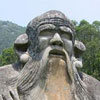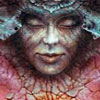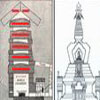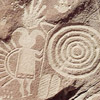Wisdom Of The Ancients ~ Part II
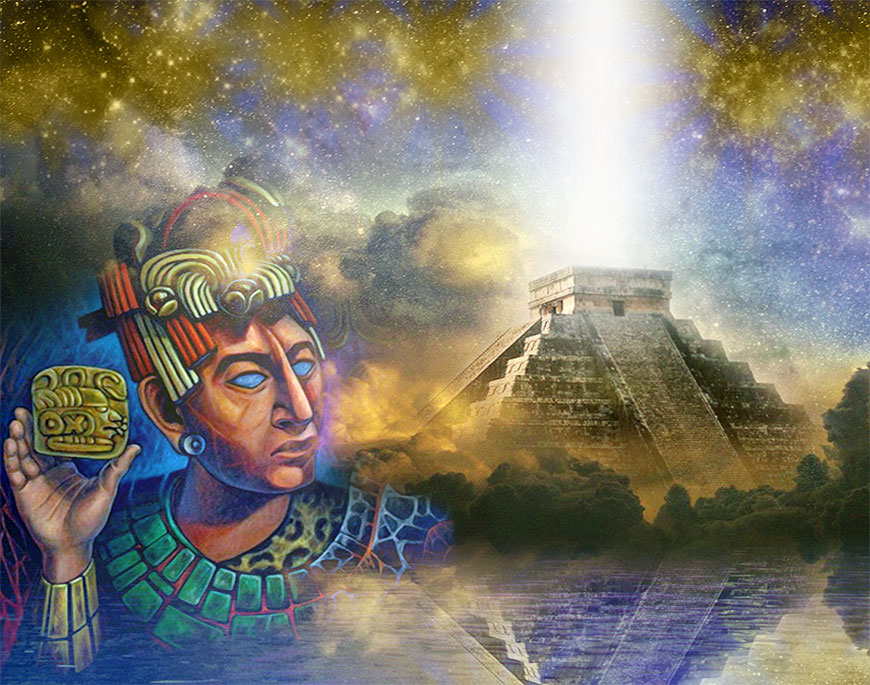 by Hilton Hotema
by Hilton Hotema
** Ancient Americans **
Anyone who dared suggest, fifty years ago, that man inhabited the New World before the Glacial Period, or that he roamed our plains, mountains and forests ten or twenty thousand years ago, would have been considered a fool.
Today there is proof that man not only dwelt in the New World during the Pleistocene period, previous to the Glacial, but that this man was the equal in skill and intelligence, if not the superior, of men in the Old World at the same time.
In various regions in this country, human artifacts have been found associated with the skeletons of known Pleistocene-period animals.
Among these animals were mastodons, camels, elephants, horses. Under the fossils were found skillfully made flint arrowheads and spearheads and other artifacts, so placed that there can be no doubt that they were deposited before the long dead animals found their graves in the gravel. In Colorado, Oklahoma, New Mexico and Texas the flint weapons being within the skeletons while others were embedded in the bones.
As these fossil mammals are typical of the first Glacial or Aftonian stage of the Pleistocene period, estimated to have been more than five hundred thousand years ago, the men who made the stone weapons used in killing these beasts, must have been well along on the road to culture long before the famed Cro-Magnan and Neanderthal man of Europe learned to make and wield a stone hammer.
The weight of authority now holds that older traces of man’s existence on earth are found in America more than in Europe, and that man went to Europe from America.
Also, in the attainments of these ancient American races appears very strong evidence against any theory of migration from any present existent land. These people came from land that now forms the bottom of the ocean.
Among these attainments are the remarkable written language of the Mayas, the architecture of the pre-Incas, the ceramics of the Nascas, the culture of the Chimus, and the calendar of the Toltecs, who are said to have been a race of tall white people, much different from the Indians now inhabiting Mexico.
Nowhere in all the present existent lands was there anything remotely resembling many of these attainments; and stranger still, and even more inexplicable, is the fact that many of these appear to have sprung into full bloom overnight, so to speak. It appears as though some super-genius had invented or evolved an idea and perfected it in a day.
So far as is known, there are no remains of preliminary stages or beginnings to show a gradual evolution or development, nor any evidence to lead one to presume that the results were the culmination of slow progress through many centuries. Hence, the invention and development of these things must have occurred in a land that does not now exist.
** Marvelous Achievement **
The Mayan writing is one of the most marvelous achievements of any race, and is known only in its most highly perfected form. Yet it must necessarily have required thousands of years for its development. But it has no counterpart, nothing remotely resembling it, in the whole world.
The Aztec calendar is another example of marvelous achievement. The Cyclopean architecture of the Andean highlands in no way resembles that of any other known land or race, and, so far as we know, there is no intermediate type of architecture between these pre-Incan and the latter Incan forms.
Nowhere else on earth are there such structures as those at Tiahuanaco in Bolivia, far up on the Andean heights, nearly fifteen thousand feet above the sea; nowhere are there any remains showing an archaic or primitive type of such work.
There are hundreds of similar examples of the same sort of amazing feats and highly perfected mathematical, astronomical and scientific attainments that seem to have no beginning, but which, judging by what we know, appear to have been transplanted, fully developed, from some distant region. No one has ever been able to find definitely the region whence they came.
If Europe had anything similar to this, the libraries could not hold the books with which scientists would flood the country. But what does the world have on this? Physical science strives to conceal it to make itself appear great, and Romanism fears it because enlightenment is always dangerous to organized fraud.
The Aztecs’ calendar-stone recorded the destruction of the earth by a great flood, and previously by fire. This information is carefully kept out of textbooks.
** Wonderful Skills Of Ancient Americans **
The story of Genesis, as recorded in the Roman Bible, dates back to very remote antiquity; very probably before it was recorded on stone, clay tablets or in any other form, it had been passed down by word of mouth for numerous centuries.
No such accurate astronomical calculations were made by any other people of their times as by the Mayas and Aztecs.
No other people invented such a remarkable form of writing in the Mayas.
No other race, not even the people of modern times, ever erected such walls and buildings as those of the pre-Incan races.
No other race ever carried out such Cyclopean works of such stupendous feats of stone cutting, as the Tiahuanacans.
No other race ever wove, by hand or machine, textiles equal to those produced by the ancient Peruvians.
And the famed Roman roads and aqueducts seem scarcely more than child’s play compared to the marvelous highways and other engineering feats of the Incans.
Perhaps the greatest of all mysteries are how the ancient civilized races of America performed their amazing feats and accomplished such astonishing works in metals and the hardest stones.
How they fashioned pieces, no larger than the head of a pin. How they cut, polished, perforated and carved topaz, amethysts, garnet, agate, crystal, and other precious stones.
How they worked friable obsidian into thin polished rings. How they executed the most beautiful and complex sculptures in the most refractory of rocks.
How they moved blocks of stone, weighing upwards of two hundred tons, for miles across country and used them in their buildings.
How they wove textiles far finer than it is possible on any modern loom.
How they cut long tunnels through mountains. How they invented the world’s most remarkable numerical system. How they evolved a marvelous written language. And how they performed countless other feats which, with the known tools, implements and devices they had at hand, might almost seem to savor of the supernatural.
The Mayas possessed a remarkable glyphed or written language in which certain events were recorded. Carved on a stone temple in Tikol they left a date 12,063 years ago.
The Aztecs used a very complete arrangement of symbols for dates and other records; they had pictographic codices that recorded their migrations in their past. But with their usual fanatical zeal, the Roman priests destroyed everything of an enlightening and educational character that they could lay their hands on, and among other things they destroyed were most of those codices.
Many of the prehistoric civilizations of the Americas are of almost inconceivable age. Some of them must go back fully fifty thousand years. And, strange to say, all show certain influences, in a way, as if all had originated from a common nucleus.
Not only did these ancient races execute the most amazing sculptures in the hardest of stone, but they did it to a degree that would be a difficult task for a modern mechanic equipped with the finest tools of steel, and they apparently did it with ease and rapidity.
There are single blocks of stone weighing many tons, fifteen feet in length, ten feet in width, and three feet thick, elaborately sculptured and formed into monolithic gateways, with portals cut with mathematical accuracy through the great mass of stone.
There are immense buildings, temples, pyramids, and underground chambers of stonework, every square inch of the surfaces of which is completely covered with deeply cut, intricate carvings.
There are stone stools, seats, images, and monuments ornamented with carved fretwork in the most complicated designs; human and other figures carved from transparent quartz, black friable obsidian and even gem stones, so beautifully cut and polished that they would be a credit to any modern lapidary working with diamond-dust.
** Greater Than The Pyramid **
H. G. Wells says that the construction of the Great Pyramid of Gizeh must have exhausted Egypt more than a great war. Yet there are stone constructions in America that exceed this pyramid, and it seems that centuries must have been required to transport hundreds of monoliths, often weighing many tons, from distant quarry to the temples.
The columns in themselves are astonishing objects. Many of them arc fifteen to twenty feet in length, from sixteen to thirty inches square, cut and tooled to rectangular, octagonal, pentagonal, cylindrical or elliptical form, and sometimes covered with symbolic sculptures and glyphs that appear to be characters with some unknown meaning.
Far up on the Andean heights, nearly three miles above sea level, are the remains of the oldest and most mysterious city in the Western Hemisphere.
** Mighty Capital Of Tiahuanaco **
Here are the ruins of Tiahuanaco, once the mighty capital of a highly civilized people whose origin, history and decline are unsolved mysteries, whose feats of engineering still seem almost superhuman, whose sculptures have no counterpart in the entire world, and who had vanished from the earth many centuries before the fall of Rome.
Although Tiahuanaco has been at the mercy of the elements and earthquakes for thousands of years, much still exists of the prehistoric city, its immense temples, its stupendous buildings and its amazing monoliths.
Those portions of the city that have defied time and man through the long ages, are the portions that speak most eloquently of the high civilization and incredible feats of the vanished race that dwelt and worshiped there.
Despite the ruin and wanton destruction of man that have occurred at Tiahuanaco, the most remarkable feature of the temple still stands almost intact–the so-called Gateway to the Sun, which stands at the western end of the terrace.
This monolithic portal is the largest known example of stone-cutting on earth. It is cut from a single massive block of andesite, thirteen feet five inches in length, seven feet two inches in height, eighteen inches in thickness, with a square doorway four feet and a half by three feet in size, cut through its center.
The western surface of the upper portal forming the lintel is cut in a series of low bas-reliefs of plain geometrical form, and with four deep niches that were probably designed to hold small images, made of gold or silver, perhaps.
The lintel on the eastern face is completely covered with beautifully sculptured symbolic figures in bas-relief, and has two deep niches, on each side of the doorway.
The sculptured symbols or figures are arranged in a series of equal-sized squares surrounding a representation of a deity, supposedly the Sun God. In either hand the semi-human figure bears a ceremonial staff, and the rays about the head terminate in miniature jaguar heads.
Flanking this central figure are the forty-eight squares, twenty-four on each side, arranged in three rows of eight figures each. All these face the Sun God as though running toward him and each carries a small scepter.
The upper and lower rows are semi-human figures with wings and crowns and are identical in all respects. The figures of the central row are repetitions of the others, aside from the fact that they have condor heads.
Below all these there is a line of sixteen carvings consisting of twelve human heads in flat relief, flanked by two condor heads.
According to the ancient Peruvian mythology, a giant condor-god carried the sun across the heavens each day; he is often represented battling with a jaguar, the god of darkness or night, thus symbolically representing the eternal conflict between night and day–a scene very similar to parts of a drama of the Egyptian Mysteries.
In all probability the sculptures upon this Gateway to the Sun represent the Supreme Deity with the various lesser deities paying him homage.
Although this elaborate symbolic carving is most interesting, it is by no means so remarkable as the ornamental design and niches on the opposite side of the huge block of cut stone.
So accurately and perfectly are these cut, so geometrically and mathematically true, that it is impossible to detect an error even by the use of calipers, a millimeter rule and a draftsman’s triangle. The same is true of the doorway itself and of all the innumerable geometrical sculptures there.
How any human beings could have cut this hard andesite rock to such perfect angles, with such true sharp edges, and often to a depth of six or eight inches from the surface, unless they possessed steel tools, and most accurate mathematical instruments, is perhaps the greatest mystery of the ruins.
Everywhere, throughout the Andean region, along the coast, and for thousands of miles north and south, are remains of prehistoric cultures showing unmistakable proofs of Tiahuanacan influence. And always these are in the most ancient or lowest strata, thus proving that the Tiahuanaco civilization was beyond question the most ancient civilization in South America and hence in the Western Hemisphere.
It is folly even to guess at the date when this city was in its glory. It must have antedated the so-called Christian era by many centuries. It must have required hundreds of years to lay out and construct the city and its stupendous edifices, and the civilization must have been flourishing for ages before it attained its culmination at Tiahuanaco.
To develop such an advanced and far-reaching civilization must have required an almost immeasurable time, and unless the Tiahuanaco civilization was brought, fully developed, from some unknown distant region, the highlands about this area must have been inhabited by civilized human beings long before the biblical Moses ever saw the light of day.
The Tiahuanacans left nothing but their ruins, their utensils and their language. It is even doubtful whether they left any human remains to aid in solving the mystery of their identity.
Many skeletons and skulls have been found in and about the ruins of the city, but it is questionable whether any of these are those of the builders of the city.
Many are unquestionably those of the much later Incan inhabitants of the region. Others are of people who, as proven by the inferior character of the pottery and artifacts associated with them, were not of the highly civilized Tiahuanaco people.
** Most Fascinating Mystery **
Until some epochal discovery is made, Tiahuanaco will remain the most fascinating mystery of all the prehistoric American cities.
In Peru and Bolivia there are immense monuments and images of a certain kind of stone that is not found within hundreds of miles of their present sites, the nearest deposits of such rock being more than a thousand miles away.
One such monolith is Saycunin or La Piedra Cansada near Ollantay. This immense stone, known as the Abandoned Monolith, measures nearly seventeen feet in length, ten feet in width and three feet in thickness.
The largest stone image recorded was that of the Willca-Huaman, which was over fifty feet in length and twelve feet in diameter. This was destroyed by Roman priests, and it is recorded that, in order to reduce it to rubble, it required thirty men working steadily for three days.
If we shall believe the statements and writings of the Spaniards who invaded the Americas, many of the men they found possessed certain powers which were inexplicable.
** An Uncanny Ability Of The Incans **
According to innumerable historians, as well as Incan traditions, the Incan races had an uncanny and seemingly supernatural ability for conveying and receiving accurate information over long distances.
According to apparently unvarnished accounts, it was as remarkable in its way as wireless telegraphy or mental telepathy.
An Incan could and often did know exactly how many men or horses were approaching long before they could be seen or heard. He could tell where or in what direction friend or foe was traveling; he could perform many more equally mysterious feats.
Everywhere, throughout Ecuador, Peru, Bolivia, and over the borders in Brazil and Chile, are scattered the ruins and remains of civilized people of whom nothing definitely is known.
Over an area of more than a million square miles there is scarcely a square mile that does not contain evidences of once having been inhabited by races who had reached a high state of culture, and many of whom performed almost incredible feats of engineering.
Everywhere among the Andean ranges and upon the deserts are the ruins of temples, palaces, great cities, immense walls, massive fortresses, and hundreds of thousands of graves and tombs containing millions of mummies.
For a distance of more than a thousand miles north and south, there is an almost endless chain of cemeteries and burial mounds extending inland to beyond the Andes. In many of these the number of dead interred is almost beyond belief.
The earth is literally filled with the dead, and there must be hundreds of millions of mummies within the area. These of course represent the accumulation of dead bodies over a period of many thousands of years.
Nowhere in the so-called Old World can there be found anything comparable.
Excerpt from Immortalism: Wisdom Of The Ages
See Part I here. Part III coming soon.
Posted in Other Topics, True History of Manwith comments disabled.


